Rodin in the United States: Confronting the Modern
Reviewed by Jonathan P. RibnerJonathan P. Ribner
Associate Professor, Boston University
Email the author: jribner[at]bu.edu
Citation: Jonathan P. Ribner, exhibition review of Rodin in the United States: Confronting the Modern, Nineteenth-Century Art Worldwide 21, no. 3 (Autumn 2022), https://doi.org/10.29411/ncaw.2022.21.3.29.
This work is licensed under a Creative Commons Attribution-NonCommercial 4.0 International License  unless otherwise noted.
unless otherwise noted.
Your browser will either open the file, download it to a folder, or display a dialog with options.
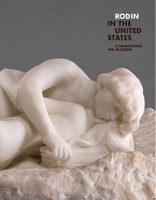
Rodin in the United States: Confronting the Modern
Clark Art Institute, Williamstown, Massachusetts
June 18–September 18, 2022
High Museum of Art, Atlanta, Georgia
October 21, 2022–January 15, 2023
Antoinette Le Normand-Romain, ed.,
Rodin in the United States: Confronting the Modern.
Williamstown, MA: Clark Art Institute; New Haven and London, Yale University Press, 2022.
260 pp.; 210 color and b&w illus.; bibliography; chronology, notes & references; index.
$60.00 (hardcover)
ISBN: 978–1–935998–51–8 (Clark Art Institute)
ISBN: 9780300264067 (Yale University Press)
So secure is Rodin’s place in the canon of nineteenth-century art—and so embedded are The Thinker (original model 1881–82, enlarged 1903) and The Kiss (original model ca. 1881–82) in popular culture—that an occasion to consider an unfamiliar aspect of his celebrity is welcome. Such is provided by Rodin in the United States: Confronting the Modern, an exhibition of fifty sculptures and twenty-five drawings with venues at the Clark Art Institute in Williamstown, Massachusetts, and the High Museum of Art in Atlanta. A number of items on the checklist are restricted to one location; what follows pertains to the installation at the Clark. Addressing the appetite in the United States for Rodin’s work from 1893 to the present, it is the most ambitious temporary exhibition of the oeuvre since Albert Elsen, Ruth Butler, and Kirk Varnedoe curated Rodin Rediscovered at the National Gallery of Art, Washington, DC (1981–82).[1] That omnivorous exhibition had approximately one million visitors and was extended for three months. Offering a new opportunity to be steeped in the oeuvre without entering the Hôtel Biron, the studio/museum in Meudon, or the Rodin Museum in Philadelphia, Rodin in the United States is narrower in scope. It is organized around the entry of the art into the United States, spotlighting women who purchased, promoted, or were gifted Rodin’s work and established it as a staple in the nation’s public collections, whether in Washington DC, New York, or San Francisco.
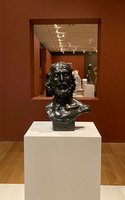
Accordingly, the sculpture and drawings are not grouped chronologically, but according to three phases of acquisition: “The Era of Collectors, 1893–1917,” “The Era of Museums, 1917–1954,” and “The Revival, 1954 to Today.” Walls of alternating tan and warm brown provide effective backdrops to the bronzes, marbles, and plasters. They meet at unexpected acute angles, imparting to the installation a dynamism at one with the works on display. Some of the walls are pierced by rectangular openings, which offer a glimpse into the adjacent space. Encouraging visitors to continue their itinerary, the openings mitigate the sense of clutter that otherwise might have arisen from close placement of multiple objects within an intimately scaled layout. A wall opening in the first room dramatically frames a bronze Bust of St. John the Baptist (original model 1880, cast 1883), prioritizing the first work by Rodin to enter a US museum; it was given to the Metropolitan Museum of Art in 1893 by Samuel P. Avery, who purchased it from an expatriate dealer in Paris, George A. Lucas, its owner since 1888 (fig. 1).
Despite the US theme, Antoinette Le Normand-Romain, one of l’Hexagone’s leading scholars of nineteenth-century French sculpture, curated the exhibition and provided the sculpture entries in the beautifully illustrated catalogue; Christina Buley-Uribe contributed entries for the drawings, as well as an essay, “The Role of Drawing in the Art of Rodin.” Apart from that essay, and Le Normand-Romain’s “At the Heart of Sculpture,” the others focus not on Rodin’s art per se, but rather on its acquisition and afterlife: Laure de Margerie, “An Established Taste: Collecting French Sculpture in America”; Véronique Mattiussi, “Rodin’s American Circle”; Elyse Nelson, “Making the ‘Little Rodin Gallery’: The Rodin Collection at the Met”; Jennifer A. Thompson, “Collecting with High Ideals and Enjoyment: Jules and Etta Mastbaum and the Rodin Museum in Philadelphia”; C.D. Dickerson III, “Sculpture at the National Gallery of Art: From Andrew W. Mellon to Katherine Seney Simpson to Today”; and Patrick R. Crowley, “Staging The Gates of Hell.”
The exhibition and catalogue bear witness to a tenacious desire for Rodin’s works, with the record for quantity held by two insatiable males, whose single-minded acquisitiveness matched the sculptor’s total immersion in his art. The vast holdings of US cinema magnate Jules E. Mastbaum—150 bronzes (including a cast of The Gates of Hell [1880–ca. 1900; purchased December 1925, cast 1926]), marbles, and plasters, and a large number of drawings—filled his Rodin Museum in Philadelphia (now part of the Philadelphia Museum of Art), completed in 1929, three years after the death of the collector. It is astounding that Mastbaum’s obsession seems to have dated only from his first visit to the Musée Rodin on September 16, 1924, when he purchased a small bronze and left an order for seven more to be cast and sent to Philadelphia. That city had seen the first exhibition of Rodin’s sculpture in the United States. The display of eight works in the 1876 Centennial Exposition in Fairmount Park had not been promising. Having worked in Brussels since 1871, Rodin exhibited with the Belgian delegation, eight of whom received medals while Rodin’s submissions were ignored.[2] Mastbaum’s hunger was shared by financier and philanthropist B. Gerald Cantor. In 1974, Cantor donated eighty-nine Rodin sculptures to the Stanford University Art Museum (today’s Iris & B. Gerald Cantor Center for the Arts)—an appropriate destination, given that Elsen had joined the Stanford faculty in 1968. Amassed after the sculptor’s death, these outsized collections postdate those of enlightened, wealthy women who treasured Rodin’s art in his lifetime and were no less eager for it to be publicly displayed. Outstanding, in this regard, is Rodin’s most important patron and promoter from the United States, Katherine (Kate) Seney Simpson, who befriended the sculptor in 1902 (she and her husband met him through the dealer Siegfried Bing) and visited Rodin in France annually until the First World War. Alma de Bretteville Spreckels—socialite, philanthropist, and wife of the sugar tycoon Adolph Spreckels—put the California Palace of the Legion of Honor (now part of the Fine Arts Museums of San Francisco) on the map as a major repository of the sculptor’s work.[3] And there was a close bond between Rodin and Loïe Fuller, whose dancing with billowing, illuminated veils caused a sensation in Paris in the 1890s. Fuller, who later served as a conduit to Spreckels, precociously staged a little-noticed exhibition of work by Rodin in New York at the National Arts Club for a week in May 1903. It is unclear why the show was so brief and how many pieces were displayed; Fuller’s list indicates nineteen sculptures (including The Hand of God [original models 1895 and before 1895] and The Thinker).
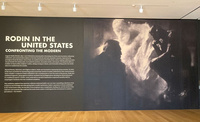
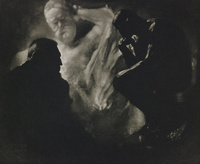
The frontispiece to the exhibition is a wall-sized reproduction of Edward Steichen’s photograph Rodin—The Thinker (1902), which utilizes the full battery of Pictorialist tonal manipulation (and two negatives) to solemnly evoke the sculptor’s cult status and mystifying creativity (figs. 2, 3).[4] In 1900, Steichen had traveled to Paris, where he presented himself to, and befriended, Rodin. From that friendship came, in 1908, the evocative nocturnal photographs of the Monument to Balzac (original model 1897, enlarged 1898), as well as this pairing of the sculptor with his most famous work, The Thinker—an enlargement of the seated figure, who originated as Dante, who ponders the fate of the damned in the tympanum of The Gates of Hell (two casts of the figure, one medium-sized and the other colossal, are included in the exhibition). Regrettably, the impact of this marvelous sculpture has been dampened by over-exposure. Presiding over the tomb of Rodin and his wife in the garden of the house and studio at Meudon, The Thinker has a personal connection to the sculptor. In Steichen’s dusky photograph, the tensed muscles that make this seated athlete, when viewed in daylight, so expressive of physical as well as mental effort are enshrouded in a pervasive darkness interrupted by fugitive streaks of glare from an unseen light source. That we are in the presence of genius is emphasized by the value contrast between Rodin’s fierce silhouette and a reversed image of his effigy of Victor Hugo, hovering in the background like ectoplasm summoned by a kindred medium. Steichen later encouraged fellow vanguard photographer Alfred Stieglitz to exhibit fifty-eight of Rodin’s uninhibited drawings of the female nude at the Little Galleries of the Photo-Secession at 291 Fifth Avenue in January 1908 (with two additional, separate exhibitions of drawings held in 1910 at what had been renamed 291), exposing New Yorkers to uncompromising European fare well before the Armory Show.
At his death in 1917, Rodin was the most famous artist in the world. That celebrity had been enhanced by the sculptor’s independent retrospective on the occasion of the Exposition Universelle of 1900, following a dual show with his friend Claude Monet in 1889 at the Galerie Georges Petit. With the blessing of the municipal authorities, Rodin followed the example set by Courbet nearly a half-century earlier, exhibiting 165 of his sculptures, as well as numerous drawings and photographs, in a pavilion on the place de l’Alma, near a principal entrance funneling visitors to the Exposition Universelle’s seventy-six thousand official exhibits. Despite his eventual fame, Rodin endured one disappointment after another: he thrice failed to enter the École des Beaux-Arts; exhibition of his first major work, The Age of Bronze (original model 1876) in Brussels and Paris (1877) raised accusations in both cities that it was cast from life; the Monument to Balzac, on which he labored for the Société des Gens de Lettres, was rejected and publicly mocked; and the decorative arts museum for which The Gates of Hell were commissioned as bronze doors was never built, leaving that twenty-year summa of Rodin’s career in plaster when he passed away.
Among Rodin’s most audacious and enduring innovations is what Elsen termed the “partial figure”—a sculpted body considered complete, though bereft of limbs or head. Spurning standard pedestals and plinths, Rodin would have his praticiens fuse smooth marble with a non-finito base in emulation of unfinished works by his idol, Michelangelo.[5] Both the expressively eruptive surfaces of the bronzes and the marbles’ illusion of palpitating warmth were alien to the simulacrum of cold flesh dear to academic sculptors. Also beyond the pale of conventional taste was willingness to expose brutal fact. The flattened breasts and aged skin of The Helmet Maker’s Beautiful Wife (1880–83), for example, shockingly contrast with the immaculate contours and eternal youth that were de rigueur for the female nude in nineteenth-century French sculpture. Within the vast body of Rodin’s drawings are renderings of dancers and female models observed in motion around the turn of the century. Some are candidly erotic; all are remote from the French tradition of draftsmanship as taught at the École des Beaux-Arts, where students were expected to master the académie—the rendering of stationary male nudity with firm exterior contour and subtle, eye-fooling chiaroscuro. And the major public works (The Burghers of Calais [1885–95] the Monument to Balzac, and The Gates of Hell) are private in conception and content. Nor does the sculptor comfortably fit within any movement. Though his work features the pessimistic eroticism and open-endedness of symbolism, Rodin resisted being called a symbolist and viewed himself as a realist, grounding his art in close study of the model.[6]
Twentieth-century French sculptors embarking on their careers prior to the First World War viewed with ambivalence a legacy both awesome and asphyxiating. In emulation of the master, Henri Matisse hired Rodin’s former model, César Pignatelli (who now called himself Bevilaqua) to pose repeatedly (as many as five hundred times) for his first major sculpture, the armless bronze Serf (1900–3), which combines Rodinesque roughness of facture with an absence of either the movement or inner turbulence characteristic of Rodin. Matisse would soon decisively dismiss Rodin’s example as antithetical to his own quest for wholeness, serenity, and balance. Mindful of his predecessor’s conception of the figure in terms of expressive anatomical parts, Matisse asserted in “Notes of a Painter” (1908) that he “could mention a great sculptor who produces some admirable pieces but for him a composition is nothing but the grouping of fragments and the result is a confusion of expression.”[7] Wholeness was also sought by Constantin Brancusi, who, having briefly worked in the Meudon studio in 1907, abjured Rodin’s reliance on praticiens and embraced direct carving, as previously practiced by Paul Gauguin. No less remote from Rodin’s example is Aristide Maillol’s Femme (ca. 1905–6; renamed La Méditerranée in 1923) which features repose, clarity of outline, and a healthful corporeality redolent of southern French sun and shore—an example of the innovative classicism of the first half of the Third Republic cogently analyzed by Richard Thomson.[8]
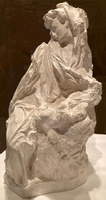
Those early twentieth-century rejections of the Rodin heritage foreshadow a decline in the sculptor’s standing among modernist artists and critics that reached its nadir following the Second World War. The turning point was 1954, when a bronze cast of the Monument to Balzac (which remained in plaster) was ordered for the collection of the Museum of Modern Art, with enthusiastic support from founding director Alfred Barr. Tutelary spirit of the Clark’s lower-level installation, that bronze stands in august isolation in its own gallery at ground level. The welcoming of the Monument to Balzac to West 53rd Street was a harbinger of groundbreaking work on the sculptor in the 1960s by Elsen and by Leo Steinberg, who upended Rodin connoisseurship by positive reconsideration of the plasters, which are central to the sculptor’s practice and provide the closest record of his modeled clay. Among the examples included in the exhibition is a Medea (ca. 1880), based on a painting of 1838 by Eugène Delacroix, a predecessor esteemed by Rodin (fig. 4). The drapery that envelops the filicide’s body was cast from an actual piece of cloth—an example of Rodin’s resourceful exploration of the reproductive medium’s potential.
Though it now requires empathetic effort to comprehend twentieth-century distaste for Rodin, signal features of his art went against the modernist grain. In addition to commitment to emotive subject matter, Rodin maintained the traditional conviction that sculpture must convey an illusion of vitality and inner life. In contrast, much modernist sculpture—whether the representational constructions of Picasso or the abstract geometries of the constructivists—is conceived as inanimate object. Rodin’s marbles were regarded with particular scorn, Alexander Calder likening them to shaving cream piled on the floor.[9] That they were the product of indirect carving by praticiens after plaster models cast from the master’s modeled clay opened their authenticity to question. In the original (1963) version of his brilliant essay on Rodin, Steinberg aptly directs the reader to “the plasters, the work in terra-cotta and wax, and the finest bronze casts,” while dismissing some of the best-known marbles as “dulcified replicas made by hired hands.”[10] Acknowledging the uneven quality of the marbles, Daniel Rosenfeld countered this disdain, insisting on the remarkable achievement represented by the finest examples and indicating both the value placed on the carved works by the sculptor and their importance to his development.[11] The quantity is formidable: some 285 individual marbles with 173 distinct subjects. Nor is the charge of inauthenticity valid. Most of the bronzes were cast posthumously. In his lifetime, Rodin left casting, patination, and finishing of bronzes largely to technicians, and his will permits the Musée Rodin to produce new casts to generate revenue. The marbles, in contrast, were often carved under the master’s close watch. Rodin guided the carvers with pencil marks and occasionally took up the mallet and chisel—ability to carve being a benefit of his work as an architectural sculptor in the wilderness years following his thwarted attempts to enter the École des Beaux-Arts.
The exhibition includes marble, bronze, and plaster examples of an emblem of the grandiose self-image that sustained the sculptor in the face of public resistance and bewilderment: The Hand of God—ironically one of Rodin’s most popular compositions (figs. 5, 6). The over-life-size marble version carved by Louis Mathet (ca. 1907) after a model of 1895, was given to the Met in 1908 by Edward D. Adams, who commissioned the work in 1906. (A plaster version was exhibited in Munich in 1896.) Cantor’s conversion to dedicated collector was sparked by an encounter with the Met’s marble in 1945. Equating the act of sculpting with divine creation, The Hand of God holds a piece of sculpture that mimics the idiom in which Rodin characteristically worked: entwined nudes engaged with a rough-hewn block. Holding this sculpture-within-a-sculpture, the divine hand emerges from a similar rocky mass, suggesting vital flesh springing from inchoate stone. To create beauty out of chaos is godlike; and the mimicry of Michelangelo’s unfinished carvings in the non-finito passages proclaims an affiliation with a forebear considered divine by his contemporaries. Embodying a conception of the sculptor’s vocation no less exalted than Victor Hugo’s biblical aggrandizement of his poetic gift, The Hand of God is a belated visual counterpart to an article of faith ubiquitous in French romanticism—belief in the poet’s sacred investiture and priestly authority.[12] A smaller, plaster version (original model before 1895, cast ca. 1900) included in the exhibition speaks to the sculptor’s endlessly inventive positioning of his pieces (fig. 7). An eyelet embedded in the plaster indicates that, unlike the vertical orientation of the marble and bronze versions, this hand was intended to hang perpendicular to the wall, turned toward the viewer—as if a sconce for God’s handiwork; that is how it was displayed in Rodin’s pavilion on the place de l’Alma in 1900.
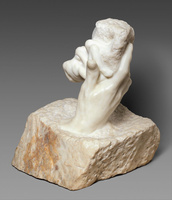
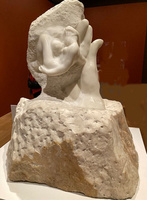
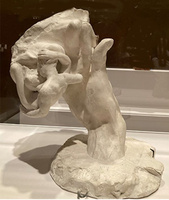
Having exhibited modern French art in Chicago since the 1870s, Sara Tyson Hallowell claimed an early place in the genealogy of North American enthusiasm for Rodin in 1893. Though not the property of a US collector, three marbles by Rodin, Cupid and Psyche (then called Francesca and Paolo, [before 1886]), Fugit Amor (also known as The Sphinx, [assembled before 1887]), and Andromeda (1885) were included by Hallowell in her Loan Collection of Foreign Masterpieces Owned in the United States, an exhibit featured in the World’s Columbian Exposition (a large figure from The Burghers of Calais and the Bust of Dalou [1883] were included in the French pavilion). Hallowell’s temerity precipitated Rodin’s first scrape with the prudery of a nation with Puritan heritage. Considered too risqué, the marbles were removed from public view after a few days; they could be seen only by request. One of the originals, Cupid and Psyche, is placed early in the exhibition and adorns the catalogue’s cover. It leaves little doubt as to why visitors blushed. We look down upon a table-top spectacle of entangled, nude lovers in the throes of passion. That Cupid’s penis is absent hardly diminishes the erotic charge of polished bodies melding with a roughly chiseled, bed-like slab, whose irregular perimeter is echoed by a thin, curving wooden base.
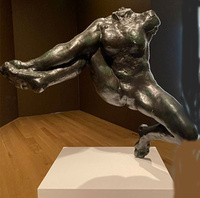
A half-century later, Rodin’s lack of inhibition was still considered objectionable. In 1953, the Boston Museum of Fine Arts deaccessioned a bronze cast of Iris, Messenger of the Gods (original model 1895; fig. 8). Characterized by Steinberg as “a woman unfurled, headless, lodged in mid-air,” this haunting partial figure bears out Robert Goldwater’s observation: “In Rodin’s work it is in fact the body as a whole that gestures.”[13] Considered unsuitable for display and kept in storage since its donation by Edward Perry Warren in 1908, the MFA’s Iris—probably not the cast included in the exhibition—was thus banned in Boston; it was sacrificed to the conservatism of an institution that, as late as 1932, had branded Matisse’s Carmelina (1903) with the accession number RES.32.14. The prefix indicates that this pre-Fauve, classicizing study of a seated nude model—a jewel in the MFA’s collection of twentieth-century European paintings—entered the museum with the reservation that it could be deaccessioned should it later be deemed unworthy of its salt.
Kate Simpson is deservedly allotted her own subsection of the installation. Daughter of George Seney, a banker and benefactor of the Met, and wife of an art-loving corporate lawyer, John Woodruff Simpson, Kate gifted her collection of twenty-eight sculptures, eight drawings, and three drypoint prints to the one-year-old National Gallery in Washington, DC in 1942, despite being a New Yorker who had actively promoted the development of the Met’s Rodin holdings. Simpson and her husband were deeply attached to her marble portrait (1902–3), the product of some sixty sittings (fig. 9). Her smooth skin and drilled corsage emerge from a chiseled, cloud-like matrix, whose weight implies gravitas, while the subtle indication of facial features in translucent marble speaks of refinement and reverie. That it remains an individuated likeness is suggested by comparison with a plaster mask (1902) from Kate Simpson’s collection (fig. 10). Inscribed “Mme K Simpson esquisse pour le portrait / 12 septembre 1909 / A. Rodin,” the mask appears to have been cast from life. Though the cropping of the bust at mid-chest recalls the late nineteenth-century fashion for neo-quattrocento busts coupés à l’italienne, the orientation is not conventionally frontal.[14] The block’s triangular footprint (more evident when viewed from above) lends a note of animation seconded by the shoulders’ asymmetry (fig. 11). If the portrait projects gentility, adjacent works reflect Simpson’s appreciation of edgier aspects of Rodin’s art. Undaunted by its truncation and battered surface, she acquired a Study for St. John the Baptist (today known as The Small Walking Man, assembled ca. 1899, cast 1903), which arrived in New York with her marble bust in late November or early December 1903; the figure was renamed The Walking Man after it was enlarged in 1907 (fig. 12). A subtly shaded drawing in stumped graphite and watercolor from ca. 1906, titled Figure Facing Forward (Serpentine?), features a graceful woman who seems to be holding a snake (fig. 13). Partaking of symbolism’s preference for mystery at the expense of closure, the motif is at once phallic and sensuously feminine.
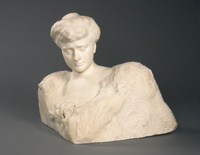
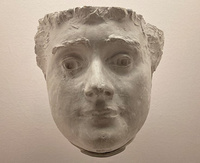
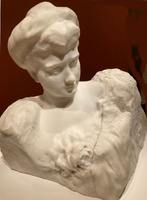
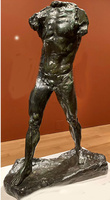
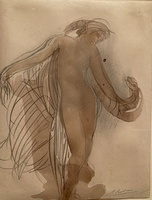
Like the art of Rodin itself, the story told by the exhibition is Janus-faced. Enamored of Michelangelo and no less dedicated to study of the model than was the École des Beaux-Arts curriculum, Rodin paid bitterly for his daring. Modernist stricture hardly blunted the love of Rodin’s art shared by Simpson, Spreckels, Fuller, Mastbaum, and Cantor. And their attachment to a sculptor who perpetuated nineteenth-century pathos and mastery of the figure prophesied Rodin’s rediscovery at midcentury. Similarly, Sterling and Francine Clark acquired paintings by academics (Jean-Léon Gérôme’s Slave Market [1866] was purchased in 1930, William-Adolphe Bouguereau’s Nymphs and Satyr [1873] in 1942) alongside those of the impressionists and their naturalist forebears (Pierre-Auguste Renoir’s A Box at the Theater or At the Concert [1880] entered the Clark collection in 1928, Monet’s The Geese [1874] in 1949, Camille Corot’s Castel Sant’Angelo [ca. 1830–32] in 1946). The Clarks’ catholicity of taste now seems prescient in view of the anti-formalist, contextual turn that, in the late twentieth century, ushered in a renaissance in the study of nineteenth-century art and buoyed the reputation of Rodin.
Notes
[1] Albert E. Elsen, ed., Rodin Rediscovered, exh. cat. (Washington, DC: National Gallery of Art; Boston: New York Graphic Society, 1981).
[2] See Christopher Riopelle, “The Rodin Museum in Philadelphia,” in Flavio Fergonzi, Maria Mimita Lamberti, Pina Ragionieri, and Christopher Riopelle, Rodin and Michelangelo: A Study in Artistic Inspiration, exh. cat. (Philadelphia: Philadelphia Museum of Art, 1997), 27.
[3] For Rodin’s US admirers, see, in addition to several of the catalogue’s essays, Ruth Butler, “Teaching Americans about Sculpture,” in Rodin: The Shape of Genius (New Haven and London: Yale University Press, 1993), 398–417.
[4] The following discussion, and that of The Hand of God below, overlap with passages in a study of romanticism’s tenacity. See my “Resistance and Persistence: On the Fortunes and Reciprocal International Influences of French Romanticism,” Studies in Romanticism 57, no. 4 (Winter 2018): 525–26.
[5] See the excellent essay by Riopelle, “Rodin Confronts Michelangelo,” in Rodin and Michelangelo, 35–49.
[6]For this point, see Robert Goldwater, Symbolism (New York: Harper & Row, 1979), 162.
[7] Quoted in Herschel B. Chipp, ed., Theories of Modern Art: A Source Book by Artists and Critics (Berkeley: University of California Press, 1968), 134.
[8] See Richard Thomson, The Presence of the Past in French Art, 1870–1905: Modernity and Continuity (New Haven and London: Yale University Press, 2021), 236–40.
[9] Elsen, “Introduction,” in Rodin Rediscovered, 12.
[10]Leo Steinberg, “Rodin,” in Other Criteria: Confrontations with Twentieth-Century Art (New York: Oxford University Press, 1972), 331. In a preamble (1971) to the essay, Steinberg modified his view: “Perhaps indeed my original case against Rodin’s marbles was overstated,” 330.
[11] See Daniel Rosenfeld, “Rodin’s Carved Sculpture,” in Rodin Rediscovered, 80–102.
[12]For this current, see Paul Bénichou, Le sacre de l’écrivain, 1750–1830: Essai sur l’avènement d’un pouvoir spirituel laïque dans la France modern, 2d ed. (Paris: Librairie José Corti, 1985).
[13] Steinberg, “Rodin,” 338 and Goldwater, Symbolism, 166.
[14] For examples of busts coupés à l’italienne, see Thomson, The Presence of the Past, 161–65.